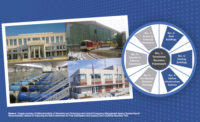Waterfront Lab
The AIANY report calls for the creation of a so-called Waterfront Lab to test innovative systems to make flood-prone areas more resilient. Among other systems, the lab could study concepts for seawalls/wave walls that dissipate storm surges and provide ecological edges; natural and armored dunes; permeable waterfront parks in flood plains; and models for waterfront districts with distributed infrastructure.
The report offers examples of flood mitigation projects from around the globe. Among these is Tokyo's cavernous underground flood diversion facility, called the G-Cans Project, which is designed to fill with water during typhoon season. Another is an underground garage at MuseumPark in Rotterdam that doubles as a container for 10 million liters of water.
The AIANY report also offers several concepts for flood resistance, including multifamily, elevated and floating structures. But design and cost issues, especially relating to elevating houses so they qualify for National Flood Insurance, are another big concern. The cost can add up to 50% to 100% of the value of the house, says architect Ginsberg, co-chairman of the AIANY initiative's housing working group.
He adds that FEMA regulations governing houses in flood zones are geared more toward the suburbs and do not fully take into account flood-proofing issues in the densest urban environment in the U.S. "FEMA lacks material for New York City," says Ginsberg. "We need a FEMA manual for multifamily housing."
The AIANY initiative recommends that once a design flood elevation of 3 feet is reached in a residential building, the city should allow the building's first residential level to be raised to 10 feet, without a penalty for exceeding the maximum building height. This would provide a full-height floor at grade, for a lobby and elevator, providing an accessible common entrance at grade for all residents and storage, parking or community space, says the report. In existing buildings, if the ground floor cannot be used, expansion should be permitted horizontally or vertically, where possible, to make up for lost habitable space.
Other zoning recommendations for housing include permitting mechanical equipment in rear yards, allowing electric rooms to be floor-area deductible and re-zoning to allow greater density in return for greater landscaped buffer zones in the flood zone.
For commercial buildings, "new developments can be resilient, the problem is with existing buildings," says Raymond Skorupa, president of health-care programming and planning consultant MPR International and a co-chair of the AIANY's critical and commercial buildings working group. Skorupa advocates upgrading zoning codes—an effort in process. He also calls for national standards for resilience.
Skorupa's working group developed a matrix of risks from flood, wind and extreme heat to 14 health care building systems and proposed risk-mitigation measures for each. In most cases, the primary advice is to locate or relocate the service above the FEMA flood elevation. The exceptions are fuel oil tanks and sump pumps and ejectors. They should be in submersible watertight rooms with bulkhead or submarine doors.
Funding Needs
New York state should establish an infrastructure bank to coordinate, allocate and maximize investment, according to the NYS 2100 Commission. The bank's mandate would be to promote more effective use of public funding and to mobilize private resources. The commission also notes that the state could better use existing funds by adopting a standard set of criteria for project selection and prioritization.
Though the AIANY report offers dozens of design, zoning, code and policy recommendations, funding sources for proposed initiatives are not addressed, except broadly. "Funding will be an ongoing issue," says landscape architect Denisha Williams, a principal of Being Here Landscape Architecture & Environmental Design and co-chair of the initiative's waterfront working group. Ginsberg adds: "As a community, we have a limited pot of money and lots of ideas, [but we have had] very limited discussion of how much money we have and what we want to do."







